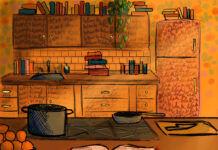As I approached by fourth week here in Ecuador, I have become more accustomed to life here and all the differences in cultures. Sadly, this week also was the third and final week of my tropical ecology class and we had our final field trip on Tuesday to the páramo, which are the highlands in Ecuador, where altitudes reach over 5000 meters. Our professor had told us that it would be cold because we were so far up, but coming from New England, I figured that meant that I might need a sweatshirt. At home, six inches of snow is a “dusting”, so I thought I could take whatever was considered “cold” in Ecuador.
Luckily, I broke down and bought some gloves (cursing the fact that I was buying gloves in a country on the equator) because it truly is a different world at 5000 meters in the sky. The bus teetered up winding and thin mountain roads to drop us off on a path in the páramo in a place called Papallacta. The cold had crept into the bus, so we had had a taste of what the climate was like, but we did not realize its harshness until we stepped off the bus and were almost blown off the side of the mountain. The temperature was probably around 40 degrees Fahrenheit, and the wind was so strong I could not believe that anything could live in such a climate. How could we still be in the same small country that held a part of the Amazon rainforest
We began our trek through the páramo, desperately trying to avoid falling or getting sucked into into the mud, but the wind was making it very difficult. Despite the dangerous terrain, the place around us was breathtakingly beautiful with rugged peaks and small plants. The fog hid our view, but the fact that anything was surviving in this crazy climate was fascinating. We came upon many cushion plants as we continued, which are a group of plants working and growing together on top of a mound of dead biomass which helps provide heat in the often freezing environment. Despite their misleading name, however, cushion plants are not very comfortable. Another surprise that soon materialized out of the thick fog was a group of lakes, some of them quite sizable. They seemed so out of place on a mountain that was otherwise relatively barren.
As we descended further down the mountain, the weather became more bearable, though the wind still kept us on our guard. Slowly, the landscape turned into something that almost looked like it came from the grasslands of Africa with waist-deep brown grasses that undulated like the sea spread all the way to the craggy Andes, though sadly there were no giraffes or elephants). In fact, it looked as if there was very little life at all. The páramo, however, is a unique ecosystem where the benefits of cooperation actually outweigh the benefits of competition, so many species work together so that they may all survive rather than compete for resources. One may be now thinking, wait a minute, doesn’t this go against everything I have learned in any biology class ever? What about “survival of the fittest?” To me, the páramo presented this beautiful metaphor for humanity and all life.
We think that the only way to survive is to be always expanding, always moving forward, always competing. What we need to learn, however, as a species, is that sometimes competition just leads to mutual destruction. If we, as humans, continue to try to out-compete the rest of nature, then I do not think we will ever survive we will never survive as a species. Even my professor said that he prefers the páramo to all other regions of Ecuador, which includes the gorgeous coast and incredible Amazon, because of the beauty of the collaboration of the organisms of the páramo in the face of such harsh conditions. It is as if it is almost “too easy” in the Amazon, there are so many resources that organisms have extremely specific niches on which they exploit and thrive, hence the area’s colossal biodiversity. The páramo, however, with its limited resources and nigh impossible conditions, forces different species to each utilise their own advantages in tandem to survive.
These ideas made me feel the magic of the páramo, and this was only augmented when we arrived at the place aptly named “The Enchanted Forest.” If you have ever seen a Disney movie, just picture the forest where all the bad things in the movie happened. In Sleeping Beauty, it’s the thicket that guards her tower. In Snow White and the Seven Dwarves, it’s where the huntsman comes for Snow White. In Tangled, it’s the forest around Rapunzel’s tower. I swear that the inspiration for all of this came from this forest in the páramo. The trees all have these huge branches and there are vines hanging from every branch; indeed every surface in the whole forest in covered in green. I have never seen such a thick forest, where there seemed to be no possible way for anything to be added to it, not even in the Amazon. I was ready for little elves and faeries to come waltzing out, but, sadly, they did not.
Despite the wonder I experienced in Tiputini in the Amazon and the
beauty of the cloud forests, I think that I liked the páramo the best. The
rugged, colossal mountains the watched over us throughout the hike, some of
them made of long-dried lava black as night, the impossible wind, and the ocean
of grass all enchanted me with their beauty and their resilience. I hope that
we as people can take something from the lessons of the páramo, and listen to
nature for once instead of trying to reap all she can give until it is gone.
![]()





































